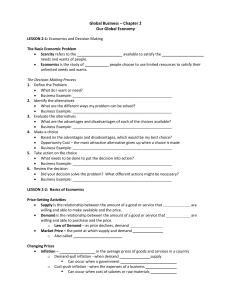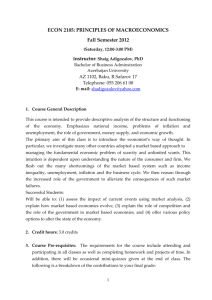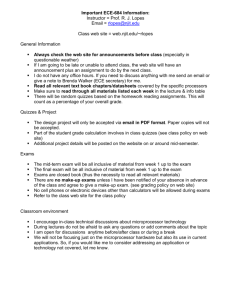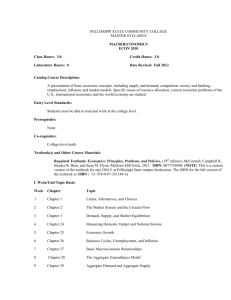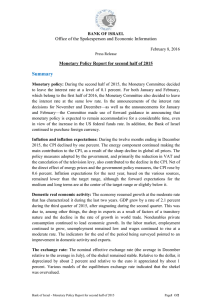JEFFERSON COLLEGE
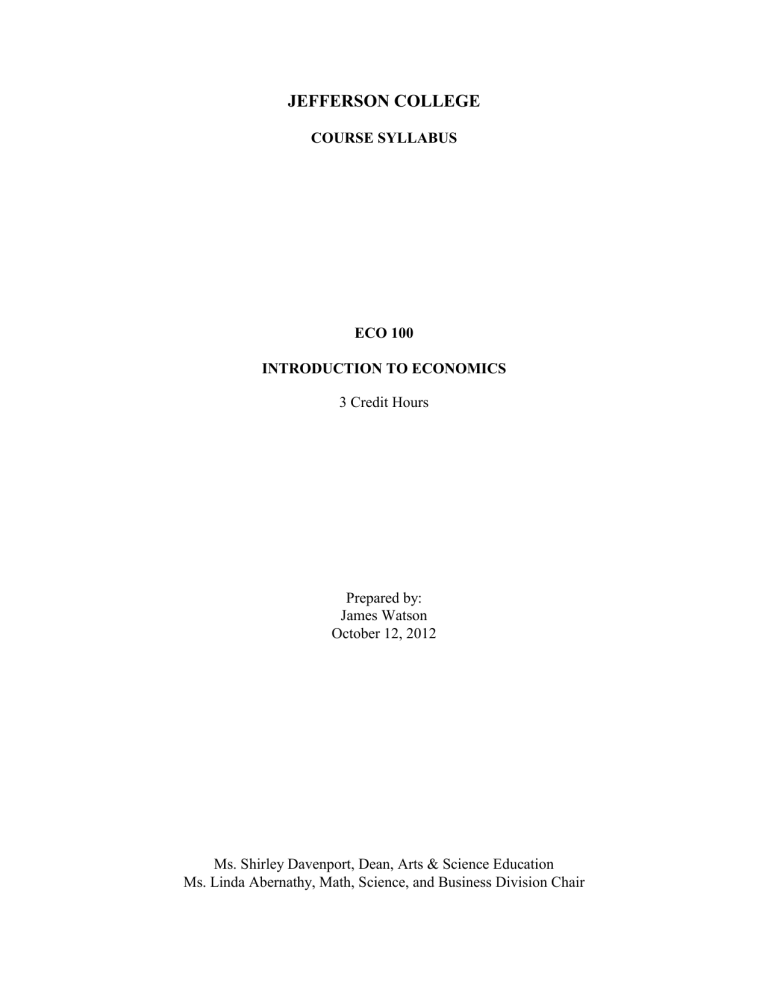
JEFFERSON COLLEGE
COURSE SYLLABUS
ECO 100
INTRODUCTION TO ECONOMICS
3 Credit Hours
Prepared by:
James Watson
October 12, 2012
Ms. Shirley Davenport, Dean, Arts & Science Education
Ms. Linda Abernathy, Math, Science, and Business Division Chair
ECO100: Introduction to Economics
I. CATALOGUE DESCRIPTION
A.
Course pre-requisites/co-requisites:
Reading proficiency
B. 3 semester credit hours
C. Introduction to Economics is a survey course that covers both macroeconomics and microeconomics. Students seeking a bachelor's degree in business should take
Macroeconomics and Microeconomics (F, S, Su, O)
II. EXPECTED LEARNING OUTCOMES/CORRESPONDING ASSESSMENT
MEASURES
Expected Learning Outcomes
Students will demonstrate a command of the basic vocabulary needed to understand how individual consumers and private businesses behave in the marketplace as well as the workings of the economy as a whole.
Class discussion
Quizzes
In class exams
Final exam
Assessment Measures
Students will recognize how various economic forces (the marketplace, the business cycle) affect their own lives.
Students will demonstrate an awareness of society’s economic problems and apply economic concepts and theories to analyze these problems.
Class discussion
In class presentations by students
In class exams
Final exam
Class discussion
Quizzes
Take home exam
In class exams
Final exam
Class discussion
Take home exam
Students will integrate information read in the textbook and heard in class discussion with information read and heard in the news media.
III. OUTLINE OF TOPICS
A. Graphs and calculations
1. Direct relationship as plotted on a graph between two variables (such as income and consumption)
2. Inverse relationship as plotted on a graph between two variables (such as
the rate of inflation and unemployment)
3. Change of data such as GDP percentage in two consecutive years
B. Resources and scarcity
1. Concept of scarcity
2. Opportunity cost
3. Concept of full employment and economic inefficiency
4. Causes of economic growth and economic decline
C. Economic growth and productivity
1. Economies of the world before and after the Industrial Revolution
2. Reasons for economic growth in the United States since 1900
D. Supply and demand
1. Law of Demand and the effect of price on the behavior of buyers
2. Forces (taste, income, etc.) that shift the entire demand curve and the effect to the price and quantity of the good being sold
3. Law of Supply and changes that effect the behavior of sellers
4. Forces (technology, changes in the costs of inputs, etc.) that shift the entire supply curve and the effect to the price and quantity of the good being sold
E. Elasticity
1. Elastic and inelastic goods
2. Effects on total revenue for the sale of elastic and inelastic goods when price changes
F. The mixed economy
1. Traditional economies
2. Development of modern economies
3. Market economies
4. Command economy
5. Mixed economy
6. Market failures that led to a greater role for government in the economy
G. Market structures
1. Perfectly competitive firm
2. Characteristics of a monopoly firm
3. Three barriers to entry into a market and market barriers that create monopoly power
4. Characteristics of a monopolistically competitive firm
5. Imperfectly competitive firm and product differentiation
6. Characteristics of an oligopoly firm
7. Anti-trust legislation in the early 20 th
century
H. Gross domestic product, the business cycle, inflation, and unemployment
1. Gross Domestic Product statistic and tools of analysis
2. Adjusted GDP for inflation
3. Distortions and limitations of the GDP statistic
4. Recession phase of the business cycle and the expansion phase of the business cycle
5. Concept of full employment and the distortions and limitations of the unemployment statistic
6. The differences between (1) inflation and deflation, (2) disinflation and hyperinflation, and (3) demand-pull inflation and cost-push inflation
7. The mitigation or prevention of a depression through fiscal policy
8. The comparison of discretionary fiscal policy with automatic stabilizers
9. Budget deficit, a budget surplus and the national debt
10. Advantages and disadvantages of deficit spending
11. Business cycle theories: innovation theory, psychological theory, monetary theory, and under-consumption theory
12. Important economic events in the U.S. economy from the 1920s to the present
I. Money, banking, and monetary policy
1. Money and the basic money supply in the U.S.
2. Series of crises in the U.S. banking system that led to the formation of the
Federal Reserve System (Fed)
3. Steps the U.S. federal government took to make the banking system safer
4. The functions of the Federal Reserve
5. Monetary policy, as carried out by the Fed, and the business cycle
6.
Fed’s successful and unsuccessful attempts at monetary policy
J. International trade and finance
1. Principle of comparative advantage and how it can make international trade advantageous for both nations
2.
Comparative advantage and absolute advantage
3. Advantages and Disadvantages of the free trade policy
4. Forms of unfair trade practices
5. Changes in U.S. trade policy throughout the 20 th
century
6. Causes of the U.S. trade deficits since 1975
7. The foreign exchange market and how to determine exchange rates in various countries
8. Comparison of a fixed exchange rate system versus a flexible exchange rate system
9. Effects of a “strong dollar” versus a “weak dollar” on a country’s economy
10. Determinants of the rise and fall of exchange rates between countries
IV. METHODS OF INSTRUCTION
A. Lecture
B. Class discussion: the news and economic principles
C. Handouts
D. Use of data (GDP statistics, trade deficits over time, etc.)
E. Multi-media presentations: websites; articles online; video; Power-point
V. REQUIRED TEXTBOOK(S)
Slavin, S. L. (2011). Economics (10th ed.). New York: McGraw-Hill/Irwin.
VI. REQUIRED MATERIALS
A. Textbook
B. Course lecture/study guide (prepared by the instructor)
VII. SUPPLEMENTAL REFERENCES
A. Newspaper and magazine articles
B. Data, articles, video and blogs from the internet
VIII. METHODS OF EVALUATION
A. Exams: multiple choice and essay
B. Quizzes: multiple choice; fill-in-the-blank; vocabulary
C. Take home exams: materials from the news and the textbook; fill-in-the-blank; short essay
D. Homework
IX. ADA STATEMENT
Any student requiring special accommodations should inform the instructor and the
Coordinator of Disability Support Services (Library; phone 636-481-3169)
X. ACADEMIC HONESTY STATEMENT
Students who are caught cheating or plagiarizing material in this course will not receive credit for the assignment in question and may be dropped from the course with a failing grade. A detailed description of the Academic Honesty Policy statement can be found in the Jefferson College Student Handbook or online at: http://www.jeffco.edu/jeffco/index.php?option=com_weblinks&catid=26&Itemid=84
XI. ATTENDANCE STATEMENT
Students earn their financial aid by regularly attending and actively participating in their coursework. If a student does not actively participate, he/she may have to return financial aid funds. Consult the College Catalog or a Student Financial Services representative for more details.

